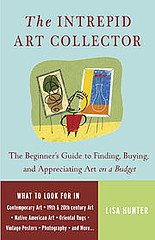Q&A With Intrepid Art Collector Lisa Hunter
 Lisa Hunter, author of the forthcoming book The Intrepid Art Collector, answered some questions I posed in an email interview the other day. Here's what she said.
Lisa Hunter, author of the forthcoming book The Intrepid Art Collector, answered some questions I posed in an email interview the other day. Here's what she said.
TiP: What are some indicators that an artist is more likely to "make it" in the art world - not necessarily to become an art star, but to do well and survive long term and leave some sort of legacy? This is something I consider when I'm thinking about buying art: Will this person still be thinking about and making art in ten or twenty years, or are they going to drop out of the art world? For some reason this matters to me, far more than whether they will be considered "notable" later.
Many new collectors assume wrongly that if an artist is "popular," the work will become more valuable. That’s not necessarily true. The work must also be relatively rare, so that collectors have to compete to own it. For example, dealers with "hot" new artists carefully control the supply of their art, and routinely turn away would-be buyers. This builds pent-up market demand, so that the artist’s prices can go through the roof later. In contrast, some popular artist their make most of their money by producing huge quantities of relatively inexpensive multiples; those aren’t likely to go up in value as much.
As for your question about whether the artist will drop out of the art market: You yourself have a role in that. Encourage the artist to keep at it by being a good collector. Try to raise interest in the artist’s career. Buy more than one piece. Cheerlead. As I've mentioned on my blog, the collector has a role in the artist’s success. Don’t just hang the picture over your couch and wait passively for the artist to "make it." Help out as much as you can.
TiP: What do artists or galleries do to help sell work which a sophisticated collector would "filter out"?
With galleries, the hard-sell is always a red flag, as is the emphasis on profits over aesthetics. Truly desirable art doesn’t need a hard sell. Whenever a dealer tells you that your art purchase is going to make a lot of money, what he really means is that it’s going to make a lot of money for HIM.
TiP: How did you get into art consulting? Do you offer private services?
TiP: Some photographers (including several I know) believe that editioning photographs is antithetical to something essential about the medium of photography (or bronze sculpture, or video projects, etc.). I'd rather not get into the merits or drawbacks of that position - many artists have their own "lines in the sand" on one issue or another, which may impact their career path but which are important to them artistically and help define their work. What I'd like to hear from you is, if an artist in a reproducible format does believe this, do you have any advice for them to help maximize the perceived and real value of their work in the eyes of collectors that are specific to this situation?
An artist who refuses to make limited editions needs to have a very, very good dealer if he or she hopes to get high prices for the work. Collectors are naturally skittish about paying a lot of money for something that may later be devalued if the work becomes commonplace.
The other option, of course, is for the photographer simply to charge low prices so that collectors don’t worry about devaluation. In that case, the artist could make money on volume, rather than on higher-priced individual sales.
TiP: What circumstances might cause an artist's work to be undervalued? (You have mentioned gender!)
The most overlooked of all are the late-blooming, 40-ish artists who are only now coming into their own style. I see tremendous talent out there that isn’t being snapped up because collectors wonder, "Well, if you're really any good, how come you haven't made it already?" It’s so unfair. A University of Chicago economist published a fascinating study about how artists and writers tend to follow one of two different career trajectories: either the young innovator who does ground-breaking work at 20, or the plodder who keeps developing and suddenly does amazing work around 40. Historically, you can find big-name examples of both. But today, the market only seems to want the young hot-shots. This stinks for mid-career artists, but presents real opportunity for collectors who are willing to trust their own "eye."
TiP: How important is an artist's full body of work, or a full series, to you when selecting artwork, and how much does it just come down to the power of one piece?
Collectors who care about resale value also consider whether the work is one of the artist’s "signature" works – i.e. if it's in the best-known style, with the characteristic subject matter. I'm personally uncomfortable with this criterion, because it can limit artists' creativity and pressure them into repeating themselves endlessly, but the market definitely has a preference for the known quantity.
I think buying art is sort of like dating. A lot of things seem attractive at first glance, and it's hard to know what you’ll be happy to live with forever. If you go on your own instincts, you definitely risk short-term infatuations and heartbreak. But if you limit yourself to what other people tell you is good, that's sort of like an arranged marriage. You may make a safe choice, even a prosperous choice, but without love, what's the point?
You can pre-order Hunter's new book, The Intrepid Art Collector, here.







No comments:
Post a Comment